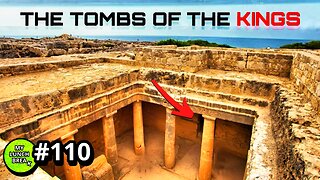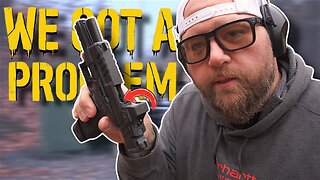Premium Only Content

#162 Electron Beam Melting (EBM)
Electron Beam Melting (EBM) is an additive manufacturing (AM) or 3D printing technology that is used to create complex metal parts and components. It is a type of powder bed fusion process, similar to selective laser melting (SLM) and direct metal laser sintering (DMLS), but it uses an electron beam instead of a laser to melt and fuse metal powder together layer by layer. EBM is particularly well-suited for producing high-quality, dense, and fully functional metal parts, making it a popular choice in industries like aerospace, healthcare, and automotive.
Here's how the Electron Beam Melting process typically works:
Powder Preparation: The process begins with a bed of metal powder, which is typically titanium, titanium alloys, or other high-temperature materials. The powder is spread evenly across the build platform.
Electron Beam Control: EBM machines use an electron gun to generate a highly focused and precise electron beam. The electron beam is directed and controlled using electromagnetic coils and deflection systems.
Layer by Layer Deposition: The electron beam is focused on a specific area of the metal powder bed, selectively melting the powder particles. The electron beam moves in a pattern that corresponds to the cross-section of the part being produced. This process is repeated for each layer of the part, with the build platform gradually moving downward as new layers are added.
Solidification: As the electron beam melts the powder, it rapidly solidifies, fusing the particles together. This produces a solid, fully dense metal layer. The process continues, adding one layer on top of another until the entire part is built.
Heat Control: EBM machines typically operate in a vacuum or low-pressure environment to prevent contamination and control the heat generated during the melting process. This helps to achieve a uniform and consistent build.
Post-Processing: Once the part is fully printed, it may require post-processing steps such as heat treatment, machining, and surface finishing to meet specific design requirements and tolerances.
Advantages of Electron Beam Melting (EBM) include:
High Material Density: EBM produces parts with a high degree of material density, making them suitable for load-bearing applications.
Excellent Mechanical Properties: EBM parts often exhibit excellent mechanical properties due to the fully melted and fused powder particles.
Complex Geometries: EBM can produce parts with intricate and complex geometries that would be difficult or impossible to achieve using traditional manufacturing methods.
Wide Material Range: EBM can work with a variety of metals and alloys, including titanium, stainless steel, and nickel-based superalloys.
However, there are some limitations and challenges associated with EBM, including high equipment and operating costs, residual stresses in the finished parts, and limitations in terms of surface finish compared to some other additive manufacturing methods. Nonetheless, EBM is a valuable technology for producing high-quality metal components for demanding applications.
www.antharas.co.uk/ companies website or top book distributors!
#BusinessStrategy
#Entrepreneurship
#Leadership
#Management
#Marketing
#Finance
#Startups
#Innovation
#Sales
#SmallBusiness
#CorporateCulture
#Productivity
#SelfDevelopment
#SuccessStories
#PersonalBranding
#Networking
#Negotiation
#BusinessEthics
#TimeManagement
#GrowthStrategies
#MarketAnalysis
#BusinessPlanning
#FinancialManagement
#HumanResources
#CustomerExperience
#DigitalTransformation
#Ecommerce
#SocialMediaMarketing
#BusinessCommunication
#ChangeManagement
-
 9:56
9:56
AV
5 months ago#1148 Press release - Flush to Fuel
17 -
 24:08
24:08
MYLUNCHBREAK CHANNEL PAGE
1 day agoUnder The Necropolis - Pt 4
148K31 -
 19:52
19:52
Adam Does Movies
10 hours ago $4.43 earnedEmilia Pérez Movie Review - It's Uniquely Awful
44.9K3 -
 20:07
20:07
BlackDiamondGunsandGear
16 hours agoSPRINGFIELD ECHELON COMPACT / NOT GOOD
46K3 -
 1:05:06
1:05:06
Man in America
16 hours agoThe Terrifying Truth Behind Chemical Fog, Wildfire Smoke & Chemtrails w/ Dr. Robert Young
44.4K57 -
 2:54:47
2:54:47
Tundra Tactical
9 hours ago $11.85 earnedSHOT Show 2025 Wrap Up!! On The Worlds Okayest Gun Live Stream
68K3 -
 LIVE
LIVE
Right Side Broadcasting Network
1 day agoLIVE REPLAY: President Donald J. Trump Holds His First Rally After Inauguration in Las Vegas - 1/25/25
3,263 watching -
 2:55:24
2:55:24
Jewels Jones Live ®
1 day agoWEEK ONE IN REVIEW | A Political Rendezvous - Ep. 107
133K41 -
 1:33:29
1:33:29
Michael Franzese
1 day agoTrump Wastes No Time: Breaking Down Trump’s First Week Executive Orders | LIVE
141K103 -
 1:26:44
1:26:44
Tactical Advisor
18 hours agoTrump Starting Strong/Shot Show Recap | Vault Room Live Stream 015
100K9